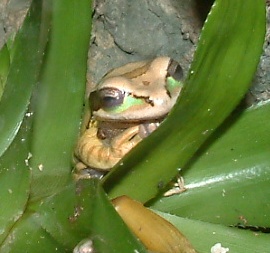Costa Rican tree frog
| Costa Rican tree frog | ||||||||||||
|---|---|---|---|---|---|---|---|---|---|---|---|---|

Smilisca phaeota , asleep in the terrarium |
||||||||||||
| Systematics | ||||||||||||
|
||||||||||||
| Scientific name | ||||||||||||
| Smilisca phaeota | ||||||||||||
| ( Cope , 1862) |
The Costa Rican tree frog ( Smilisca phaeota ), which is often also called the masked tree frog , belongs to the family of the tree frogs i. w. S. (Hylidae) to the genus Smilisca , which consists of six species .
description
The masked tree frog reaches, depending on gender , a head-trunk length of up to 6.5 centimeters for the males and up to 8 centimeters for the females. The upper side of the body is predominantly reddish-brown in color during the day, but can change to greenish at night when the frogs are active. The underside is white to cream in color. A dark brown stripe or a dark brown pattern extends from the tip of the snout to behind the eyes , which is characteristic of this species.
distribution
Masked tree frogs are common in Central America from eastern Honduras through Nicaragua , Costa Rica and Panama to South America, where they can be found in northwestern Colombia and Ecuador. Here, in tropical rainforests , they inhabit the edges of bodies of water, which can be of different sizes. They can be found at altitudes of up to 1600 meters. As a cultural follower, they can also be found near settlements , parks and gardens .
food
The masked tree frog mainly eats insects , which it can overwhelm due to its size.
Reproduction
A specific season for laying the spawn cannot be determined. The females lay the spawn, which consists of around 300 eggs , usually in suitable waters after heavy rainfall. These can be small pools, but also larger puddles. The deposited spawn swim in clumps on the surface of the water or sink to the bottom. After only three days, the larvae ( tadpoles ) leave the eggs. Together with their tail, they reach a body length of up to 30 millimeters. After another 27 days, the young frogs have fully developed and go ashore. At this time they are 1.5-2 cm in length. The young frogs have a uniform brown color, which only changes to the adult color when a length of about 4 cm is reached. The masked tree frog has a life expectancy of around three to four years.
Danger
The species has a relatively large range and is common in it. It is therefore not considered to be at risk (“least concern”).
Systematics and taxonomy
The species was first described as Hyla phaeota in 1862 by the American zoologist Edward Drinker Cope . The genus Smilisca was also described by Edward Drinker Cope in 1865 , but Smilisca phaeota was not placed in this genus until 1952.
Individual evidence
- ↑ Peter Dollinger: Costa Rican masked tree frog . Zoo animal lexicon, accessed on May 17, 2020.
- ↑ Darrel R. Frost: Smilisca phaeota (Cope, 1862). Amphibian Species of the World: an Online Reference, Version 6.1, American Museum of Natural History, New York 1998-2020, accessed May 17, 2020.
- ↑ a b Smilisca phaeota in the endangered Red List species the IUCN 2020 Posted by: IUCN SSC Amphibian Specialist Group, 2019. Retrieved on 17 May 2020th
- ↑ Smilisca phaeota at Amphipiaweb, accessed on May 17, 2020.
- ↑ Edward Drinker Cope: Catalogs of the reptiles obtained during the explorations of the Parana, Paraguay, Vermejo and Uraguay Rivers, by Capt. Thos. J. Page, USN; and of those procured by Lieut. N. Michler, US Top. Eng., Commander of the expedition conducting the survey of the Atrato River. Proceedings of the Academy of Natural Sciences of Philadelphia, 14, 1862, pp. 346-359 (first description).
- ^ Edward Drinker Cope: Third contribution to the herpetology of tropical America. Proceedings of the Academy of Natural Sciences of Philadelphia, 17, 1865, pp. 185-198.
literature
- Edward Drinker Cope: Catalogs of the reptiles obtained during the explorations of the Parana, Paraguay, Vermejo and Uraguay Rivers, by Capt. Thos. J. Page, USN; and of those procured by Lieut. N. Michler, US Top. Eng., Commander of the expedition conducting the survey of the Atrato River. Proceedings of the Academy of Natural Sciences of Philadelphia, 14, 1862, pp. 346-359. (First description).
- Twan Leenders: A Guide to Amphibians And Reptiles of Costa Rica. Zona Tropical, Miami 2001, ISBN 0-970-56780-4 .
Web links
- Darrel R. Frost: Smilisca phaeota (Cope, 1862). Amphibian Species of the World: an Online Reference, Version 6.1, American Museum of Natural History, New York 1998-2020, accessed May 17, 2020.
- Smilisca phaeota in the endangered Red List species the IUCN 2020 Posted by: IUCN SSC Amphibian Specialist Group, 2019. Retrieved on 17 May 2020th